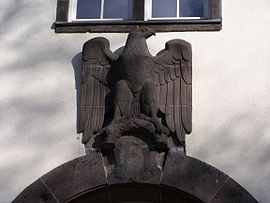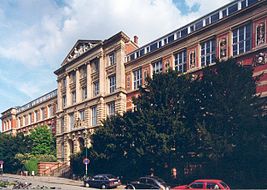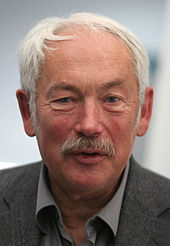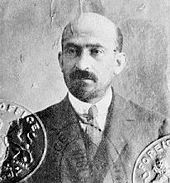- Technische Universität Darmstadt
-
Technische Universität Darmstadt (TU Darmstadt) Technische Universität Darmstadt 
Motto mens agitat molem (mind drives matter) Established 1877 Type Public university President Prof. Dr. Hans Jürgen Prömel Admin. staff 2,100 Students 23.100 (Winter term 10) Location Darmstadt, Germany Affiliations EUA (European University Association), CLUSTER (Consortium Linked Universities in Science, Technology Education and Research), CESAER (Conference of European Schools for Advanced Engineering Education and Research), TIME (Top Industrial Managers for Europe), CRE (Association of European Universities CRE-Columbus), EAIE (European Association for International Education), PACE (Partners for the Advancement of Collaborative Engineering Education), IAU (International Association of Universities) Website tu-darmstadt.de/index.en.jsp The Technische Universität Darmstadt, abbreviated TU Darmstadt, is a university in the city of Darmstadt, Germany (Note, that while Darmstadt University of Technology is occasionally used in English translations, its official English name[1] is also "Technische Universität Darmstadt"). It is well known internationally for its achievements in the areas of engineering, political science, and computer science.[citation needed] Historically, it was the first university in the world (in 1882/83) to set up a chair for and offer a course in electrical engineering[2].
Contents
History
On October 10, 1877 Ludwig IV, Großherzog von Hessen und bei Rhein (Grand Duke of Hesse), named the Polytechnic School Technische Hochschule zu Darmstadt (Darmstadt Polytechnic) and thereby raised the status of this educational institution to that of a university so that the Abitur (diploma from German secondary school qualifying for university admission or matriculation) became the basis for admission. In 1899 the TH Darmstadt was granted the right to award doctorates.
Early beginnings
The University's history is varied: its early phases began with the Höhere Gewerbschule (Higher Trade School), which was founded in 1836 and received its own building near the 'Altes Pädagog' on Kapellplatz in 1844, followed by the Technische Schule (Technical School) in 1864 and the Großherzoglich Hessische Polytechnische Schule (Grand Ducal Hessian Polytechnic) in 1868. At that time, heated discussions were continually held in political circles on the issue as to whether such a poor state as the Grand Duchy of Hesse could afford a technically-oriented higher educational institution, or even a polytechnic. After the foundation of the TH Darmstadt in 1877, student numbers kept on being so low that in the years from 1881 to 1882 there were long debates in public about closing down the University. In this difficult situation, the local government and the University made the courageous decision to set up the first chair of electrical engineering worldwide. Thus the School of Electrical Engineering came into being as the sixth faculty of the TH Darmstadt, which was a novelty in academia, because until then no other polytechnic or university had had its own Faculty of Electrical Engineering. This forward-looking higher education policy paved the way for Darmstadt to take up a leading position in the rapidly developing field of Electrical Engineering, which in turn led to a continuously rising number of students, so that the closure of the TH Darmstadt never was demanded again.
First steps as a university
In 1895 new buildings were opened in Hochschulstrasse: the 'Alte Hauptgebäude' (the 'Old Main Building' of the University) and an institute building directly opposite. During the two decades before the World War I, all disciplines of the university underwent diversification and expansion. New disciplines such as Paper Making and Cellulose Chemistry were introduced, and as early as 1913 a Chair of Aeronautics and Flight Mechanics was set up.
Meanwhile, the political climate had become stormier, and a growing political polarization exploded in Darmstadt over the question of foreign students. The TH Darmstadt had an extraordinarily large number of foreign students. In 1906, for instance, as many as three quarters of the Electrical Engineering students were from abroad, mainly from states of eastern Europe.
After the World War I there was an urgent need for reform of the education system at the TH Darmstadt, which was seen as a prerequisite for meeting the requirements of a modern industrial society. Intense discussions were held on the aim of extending the curriculum beyond the purely technical education in order to prepare the engineer for his leading role in society. A concrete step in this direction was taken in 1924, when the 'General Faculty', which until then had combined all the non-technical subjects, was divided into a Department of Mathematics and Natural Science and a Department of Cultural Studies and Political Science. Moreover, the measures taken to provide students with knowledge outside their own narrow field of study included the upgrading of Economics and the creation of professorships in Political Science, History of Technology and Sociology.
Restart after WW II
 Eagle above the rear main entry to the Robert-Piloty building, department of Computer Science. Note the effaced swastika under the eagle
Eagle above the rear main entry to the Robert-Piloty building, department of Computer Science. Note the effaced swastika under the eagle
On the night of September 11 September 12, 1944 eighty per cent of the city, including many of the university's buildings were destroyed during a bomb attack. For a short period in 1945 the TH Darmstadt had been closed by decree of the Allies before it was reopened in 1946. In spite of the difficult post-war situation, university staff and students alike managed to settle down to university work in the severely damaged buildings, which had to be used as a makeshift solution.
As early as 1947 the TH Darmstadt played host to the first 'Internationaler Kongress für Ingenieurausbildung - IKIA' (International Congress on Engineering Education), at which the participants discussed the moral responsibility of the technical intelligentsia and of the scientific elite in politics and society. In view of the disastrous consequences of the war, the participants committed themselves henceforth to do research and teaching in engineering and scientific disciplines solely for the peaceful development of mankind.
The post-war period of reconstruction was largely based on a major development programme in the sixties, by means of which universities and the state reacted to the continuously rising numbers of students. Since almost no land was available in the city centre for new construction projects, the decision was taken in 1963 to use the 'Lichtwiese' (a former airfield on the outskirts of the city) as a site for building extensions to the TH. Thus in the late sixties and in the early seventies numerous buildings, including a new student cafeteria, were erected there and ultimately became the university's second campus.
University reforms in the 1970s
After 1968 the university reform, having been initiated by the student movement, was beginning to take shape both at a national and a regional level. It aimed at creating clear university structures and the involvement of all university members in decision-making processes. In 1970 the 'Hessisches Hochschulgesetz' (Higher Education Laws of the Federal State of Hesse) came into force. These gave the TH Darmstadt, along with other Hessian universities and polytechnics, a new structure based on the introduction of a presidential statute and a unified administration as well as the subdivision of the University structure into schools.
In the mid 1970s there was another rapid rise in student numbers. Staff development, however, lagged far behind, resulting in inevitable restrictions on admission imposed either by the central government or by the University. Regardless of the staff's heavy workload, the TH Darmstadt managed to set the course for the future, as evidenced by the School of Information Science, established in 1974, the 'Zentrum für Interdisziplinäre Technikforschung – ZIT' (Centre for Interdisciplinary Studies on Technology), founded in 1987, and the School of Materials Science, established in 1989. This School, which offers a new course of studies has been housed in a new building on the Lichtwiese since 1996.
Renaming and Autonomy
By the end of the 20th century, the TH Darmstadt had had the legal status of a university, and had been offering a correspondingly wide range of subjects, for over a hundred years. For these reasons, and also with the objective of sharpening public awareness of the university's status at home and abroad, the TH Darmstadt was renamed Technische Universität Darmstadt (also its official English name is Technische Universität Darmstadt albeit often called Darmstadt University of Technology) on October 1, 1997. This name change was partly prompted by misunderstandings that had occurred in English-speaking countries, where 'Technische Hochschule' had often been mistakenly transliterated as 'Technical High School', providing a totally misleading connotation.
On January 1, 2005, the TU Darmstadt became the first public German university to be given administrative autonomy. New administrative structures were put into place, and their success is being evaluated. For instance, the university can now autonomously administer its budget and buildings. Also, the university can hire professors and negotiate their salaries by itself (formerly this was done by the State of Hesse).
Faculties
There are 13 faculties which altogether offer about 40 courses of studies. Thus the TU Darmstadt offers a broad range of academic science to students and scientists. However, some faculties are rather small (especially those dealing with economics, politics, law and social sciences) and while degrees can be gained in most of these smaller faculties, they are basically retained to provide a broader outlook (for both the students and the institution itself) to what would otherwise be an exclusively science-and-technology-centered focus.
The faculties are:
- Computer science
- Business administration, Economics and Law
- Social sciences and History
- Human sciences (Education, Psychology and Sports)
- Mathematics
- Physics
- Chemistry
- Biology
- Material- and Geo-Sciences
- Civil engineering and Geodesy
- Architecture
- Mechanical engineering
- Electrical engineering and Information technology
Academic Profile
The close cooperation between science and economy is an indispensable prerequisite for success. For that reason students are encouraged to learn how to put scientific ideas and principles into effect and to demonstrate in their essays and dissertations how to tackle, analyse and solve problems, e.g. in the areas of industrial processes and practices.
Research projects at the University are initiated and financed to a large extent by industrial and commercial concerns. Moreover, the University's successful collaboration with local companies is also based on a twofold strategy: the appointment of distinguished scientists and engineers to the post of professor at the University and the University's commitment to management development in companies.
The University offers a wide range of subjects, not only in the traditional fields of natural and engineering sciences, but also in those of social and human sciences, which was one of the main reasons for renaming the TH Darmstadt 'Technische Universität Darmstadt' in the autumn of 1997. The subjects of these major areas of human knowledge add to the teacher training for the teaching profession both at secondary schools and vocational schools and furthermore make Industrial Engineering as taught in Darmstadt an attractive course of study. The creation of new degree courses leading to bachelor's and master's degrees is also based on these academic standards and follows the European standardization of academic education.
Research
The principle of the indivisibility of teaching and research is common to all German universities. Mention must be made, however, that research at the TU Darmstadt has had a long and particularly successful tradition to date. Thus research is being carried out at more than two hundred institutes as well as at the Zentrum für Wissenschaftliches Rechnen - DZWR (Centre of Scientific Computing), where the focus is on interdisciplinary work, and at the Zentrum für Interdisziplinäre Technikforschung - ZIT (Centre of Interdisciplinary Studies of Technology). Moreover, at the TU Darmstadt there are several Sonderforschungsbereiche - SFB (collaborative research units) as well as several Graduiertenkollegs (programmes of lectures for postgraduates planned and run by experienced members of the University's research and teaching staff), all of whom profit from financial support and expert advice provided by the Deutsche Forschungsgemeinschaft - DFG (National Science Council). In the Mathematics Department, the theory of Formal concept analysis has been developed with an extensive on-going programme and annual conferences.
The scientific infrastructure provided by the University has attracted a considerable number of national and international research institutions to the Wissenschaftsstadt Darmstadt (Darmstadt - City of Science), who on their part collaborate with the TU Darmstadt on many projects. Among them are, for example, the Deutsche Kunststoffinstitut - DKI (German Institute of Plastics Materials), the Technologiezentrum Darmstadt - TZD of the Deutsche Telekom (Research and Technology Institute of the Deutsche Telekom), the Gesellschaft für Schwerionenforschung - GSI (Heavy-Ion Research Institute) at Wixhausen, the Fraunhofer Institute for Secure Information Technology SIT ( collaboration in the Center for Advanced Security Research Darmstadt - CASED), the European Space Operations Centre - ESOC, the European Organization for Meteorological Satellites - EUMETSAT, and the Fraunhofer Institute for Structural Durability and the Fraunhofer Institute for Computer Graphics. The collaboration with the University ranges from joint research projects to bearing joint responsibility for decisions taken at managerial level of the scientific institutions.
Research Profile
In July 2010, TU Darmstadt defined five Research Clusters which characterize its research profile:
- Thermo-Fluids and Combustion Engineering
- New Materials
- Nuclear and Radiation Science
- Integrated Product and Production Technology
- Future Internet
TU Darmstadt understands Research Clusters as comprehensive academic networks with high international visibility.[3]
In addition, TU Damstadt has installed two research priority areas:
- Computational Engineering
- Urban Research
Research Priority Areas are understood as coordinated research activities with significant visibility in TU Darmstadt’s research profile.[4]
International Life
With more than 20%, the percentage of foreign students at the TU Darmstadt is clearly higher than the average of German universities of 8%, though at times, especially early in its history, almost a quarter of its students were foreigners, especially from Eastern Europe.
Scientific co-operation on a contractual base is maintained with more than 65 partner universities all over the world.
The University also participates in Erasmus Mundus programme of European Commission offering MUNDUS URBANO master course International Cooperation and Urban Development. [1]
The university is member of different European networks, such as TIME network. The European Credit transfer system ECTS has been introduced for almost all courses of study.
The student group IDEA (International Darmstadt Exchange Alumni) provides an interesting programme for all international Students of the University. At the beginning of each term there is an integration week organised.
Knowledge Transfer
In order to put innovative ideas and research results more quickly into effect the Innovationsgesellschaft Darmstadt mbH (Darmstadt Society for Innovations, Ltd) was founded. The founder-members involved in drawing up the project of a Technologie- und Innovationszentrum - TIZ (Centre of Technology and Innovation), which was completed in spring 1999, consist of the TU Darmstadt, the City of Darmstadt, the Darmstadt Chamber of Commerce and Industry, the Administrative district of Darmstadt-Dieburg, the Sparkasse Darmstadt (Darmstadt savings bank) and the Sparkasse Dieburg (Dieburg savings bank), the Fachhochschule Darmstadt(Darmstadt University of Applied Sciences), and the Zentrum für Graphische Datenverarbeitung - ZGDV (Computer Graphics Center). The Center's infrastructure enables young entrepreneurs to rent business premises and to benefit from a consultancy service not only in matters of introducing new technologies but also in matters of accountancy and law at prices that are within their means.
In the meantime a number of young scientists, former students and researchers at the TU Darmstadt who have made up their mind to become independent businessmen, use the TIZ in Darmstadt as their base. Offering this form of knowledge and technology transfer, the University contributes to the economic development of Southern Hesse.
Notable faculty and alumni
- Günter Behnisch (* 1922), architect (Olympic Stadium (Munich))
- Hanns-Peter Boehm (*1928), chemist and a pioneer of graphene research
- Kurt Heinrich Debus (* 1908), rocket scientist and first Kennedy Space Center director
- Mikhail Dolivo-Dobrovolsky (1862–1919), inventor of the three-phase electrical motor
- Paul Friedländer (1857–1923), chemist
- Peter Grünberg (* 1939), physicist, discoverer of the Giant magnetoresistance effect, Nobel laureate (2007)
- Gerhard Hennige (* 1940), Olympic medal winner
- Gerhard Herzberg (1904–1999), chemist, physicist and Nobel laureate (1971)
- Karl Küpfmüller (1897–1977), electrical engineer
- Ernst Neufert (1900–1986), architect
- Bert Rürup (* 1943), former chairman of the German Council of Economic Experts
- Frank Schimmelfennig (* 1963), political scientist
- Bernhard Schlink (* 1944), former judge and writer (The Reader)
- Ernst Schröder (1841–1902), mathematician
- Gerhard Sessler (* 1931), electrical engineer and inventor of the Electret microphone
- Rudolf Wille (* 1937), mathematician
- Hermann Zapf (* 1918), typeface designer (Palatino, Optima, Zapfino)
- Eduard Zintl (1898–1941), chemist and discoverer of the Zintl phase
- Franz-Josef Kemper (* 1945), sociologist and track-and-field athlete
- El Lissitzky (1890–1941), architect and designer
- Ernst May (1886–1970), architect and city planner (New Frankfurt)
- Fritz von Opel (1899–1971), rocket pioneer
- Karl Plagge (1897–1957), Righteous Among the Nations
- Chaim Weizmann (1874–1952), chemist and first president of Israel
Points of interest
- Botanischer Garten der TU Darmstadt, the university's botanical garden
International Partner Universities
Africa
- Ethiopia
- Eritrea
Australia/Pacifica
- Australia
- University of New South Wales, Sydney
- Curtin University of Technology, Perth
- New Zealand
- University of Canterbury, Christchurch
Asia
- Pakistan
- University of Engineering and Technology, Lahore
- Allama Iqbal Open University, Islamabad
- China
- Tsinghua University, Beijing
- Tongji University, Shanghai
- India
- Indian Institute of Technology, Kanpur
- Indian Institute of Technology, Kharagpur
- Indian Institute of Technology, Bombay
- Indian Institute of Technology, Madras
- Indian Institute of Sciences, Bangalore
- Tata Institute of Fundamental Research, Bombay
- Japan
- Tokyo University, Tokyo
- Nihon University, Tokyo
- Tohoku University, Sendai
- Korea
- Seoul National University, Seoul
- Ewha Womans University, Seoul
- Mongolia
- Mongolian University of Technology and Science, Ulaanbaatar
- Russian Federation
- Yakutsk State University
- University for International Law and Economics, Moscow
- University of Economics and Finances, St. Petersburg
- Moscow Technical State University, Moscow
- Sri Lanka
- University of Colombo, Colombo
- Vietnam
- University of Transport and Communication, Hanoi
South East Asia
- Indonesia
- Institute of Technology Trisakti, Jakarta
- Tenth of November Institute of Technology, Surabaya
- Institute of Technology Bandung, Bandung
- Malaysia
- Singapore
- Taiwan R.O.C.
- National Cheng Kung University, Tainan
- Thailand
North America
- USA
- Virginia Tech, Blacksburg
- Worcester Polytechnic Institute, Worcester
- State University of New York, Buffalo
- University of California, Berkeley
- University of Illinois, Urbana-Champaign
- University of Colorado, Boulder
- Tulane University, New Orleans
- Canada
- University of British Columbia, Vancouver
- University of Saskatchewan, Saskatoon
- University of Ottawa, Ottawa
- Mexico
- Universidad Autónoma de Nuevo León, Monterrey
South America
- Argentina
- Universidad Católica Argentina, Buenos Aires
- Brazil
- Universidade Estadual de Campinas, São Paulo state
- Pontifícia Universidade Católica, Rio de Janeiro
- Universidade Federal do Paraná, Curitiba
- Universidade de São Paulo
- Universidade Metodista de Piracicaba, Piracicaba
- Colombia
- Universidad Nacional de Colombia, Bogotá
Middle East
- Iran
- Sharif University of Technology, Tehran
- Israel
- Ben Gurion University of the Negev, Beersheva
- Turkey
- Middle East Technical University, Ankara
- Sabanci University, Istanbul
See also
Affiliated Research Institutions:
- CASED
- UKP Lab
References
- ^ Übersetzungsvorschläge deutsch-englisch zu Begriffen aus dem Hochschulbereich (http://www.tu-darmstadt.de/presse/uebersetzen.tud)
- ^ History of the department of Electrical Engineering: http://www.etit.tu-darmstadt.de/fachbereich/geschichte_1/index.de.jsp (German)
- ^ Research Profile of TU Darmstadt. TU Darmstadt Homepage. Visited 17 September 2010.
- ^ Research Profile of TU Darmstadt. TU Darmstadt Homepage. Visited 17 September 2010.
External links
- English Website of the Darmstadt University of Technology
- International Master Program Information & Communication Engineering
- Bulgarian Student Organization "Syedinenie"
- Technische Universität Darmstadt in moveonnet
Coordinates: 49°52′39″N 8°39′23″E / 49.8775°N 8.65639°E
Top Industrial Managers for Europe (T.I.M.E. network) Austria Belgium Czech Republic Denmark Finland France Germany Greece Hungary Italy Norway Poland Portugal Russian Federation Spain Universidad de Sevilla · Universidad Politécnica de Madrid · Universitat Politècnica de València · Universidad Pontificia Comillas · Universitat Politècnica de CatalunyaSweden Switzerland Turkey United Kingdom European University Association · Networks of European universities · European Society for Engineering Education · European Federation of National Engineering Associations Conference of European Schools for Advanced Engineering Education and Research Aalborg · Athens Polytechnic · BME · BUT · Chalmers · CTU Prague · DTU · École centrale Paris · EPFL · ETH Zurich · Florence · Ghent · GIT · Hanover · Heroit-Watt · INSA de Lyon · INSA de Toulouse · IST · ITU · Karlsruhe · KTH · KTU · KU Leuven · LTH · METU · NTNU · ParisTech · Politecnico di Milano · POLITO · Porto · PUB · Queen's · PUT · RWTH Aachen · Southampton · Stuttgart · Supélec · Technion · Thessaloniki · TKK · TPU · TU Berlin · TU Crete · TU Darmstadt · TU Delft · TU Dresden · TU Eindhoven · TU Hamburg · TU Ilmenau · TU Munich · TU Vienna · TU Warsaw · TUT · Twente · UCL · UCD · UPC · UPM · UPV
Categories:- University research collaboratives
- Darmstadt University of Technology
- Darmstadt
- Universities and colleges in Germany
- Universities and colleges in Hesse
- Technical universities and colleges
- Educational institutions established in 1877
Wikimedia Foundation. 2010.



